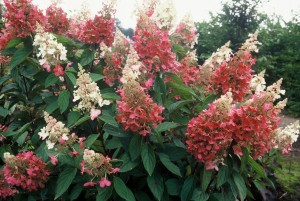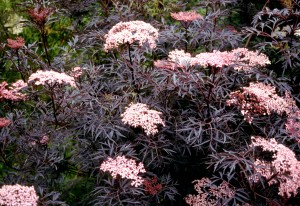Top 10 Flowering Shrubs
This list no doubt will change over time (maybe tomorrow), but for now, the following are my top 10 favorite flowering shrubs for Pennsylvania gardens:
1.) Spirea Mellow Yellow (Spirea japonica ‘Ogon’). Texture, color, multi-season interest, low care, durability… this shrub has it all.
Mellow Yellow starts the season by nearly covering itself with dainty white flowers. It’s one of the earliest shrubs to bloom – typically end of March.
Then as the flowers fade, the narrow, willowy, golden foliage emerges to give the plant its showy season-long finely textured, golden look. The habit is loose and arching and about 5 to 6 feet tall and wide, unless you want to prune it to less.
In November and December, the foliage turns coppery to burnt orange-gold before finally going bare. It’s a great focal-point plant all season and has no bug, disease or animal issues. Best in full sun but also does fine in part shade.
2.) Panicle hydrangeas (Hydrangea paniculata). Also sometimes called “tree-type” or “PeeGee” hydrangeas, these are upright hydrangeas that flower on new wood from July into fall.
The flowers are more cone-shaped and generally white, pink, rose or bicolor instead of the rounded blue of the more familiar big-leafed hydrangeas (Hydrangea macrophylla).
Panicle hydrangeas not only have big and long-lasting flowers, they’re much more sun-tolerant than the big-leaf hydrangeas and bloom reliably each year (unlike the big-leaf types, which suffer from flower-bud dieback in cold winters).
My favorites are Limelight (white) and Pinky Winky and Quick Fire (white/rose bicolors). They’ll grow 7-by-6 feet, but if that’s too big, look for more compact varieties, such as Little Lime, Bobo and Little Quick Fire. Full sun to part shade.
3.) Witch alder ‘Mt. Airy’ (Fothergilla x intermedia). I’m not sure why more people don’t plant this trouble-free U.S. native shade shrub.
Witch alder grows 4 to 6 feet tall with a slightly narrower spread, although it can “fatten out” in time if you let its emerging root shoots walk.
White bottle-brush flowers emerge in early spring and smell like licorice. Some varieties have bluish foliage in summer. But I like ‘Mt. Airy’ best for its neon golden fall foliage.
All witch alders have nice fall foliage, though, ranging from scarlet to red/gold to burnt gold. They’re easy to grow and deserving of more use. Best in shade to part shade.
4.) Oakleaf hydrangea (Hydrangea quercifolia). Here’s another U.S. native shrub that’s not used in landscapes nearly as much as it should be.
Oakleaf hydrangeas have four-season interest – large, oak-shaped leaves; white cone-shaped flowers in early summer; burgundy fall foliage, and peeling cinnamon-colored bark for winter interest.
Snow Queen and Snowflake are two very good 6- to 8-footers. Check out ‘PeeWee’ and the new pink-blooming ‘Ruby Slippers’ if you prefer something more like 5 feet tall and around.
I’ve seen oakleaf hydrangea do well in all kinds of light, from full sun to nearly full shade.
5.) Winterberry holly (Ilex verticillata). Winterberry holly is a Pennsylvania native shrub that really shines in late fall through winter thanks to its big, bright red berries.
Female types produce the fruits. Just be sure to also plant at least one suitable male nearby that overlaps bloom time so the females can be pollinated.
Winterberries function as dark-green backdrop shrubs throughout most of the season, growing anywhere from 6 to 12 feet tall, depending on variety. Prime time is fall when the leaves turn yellow and berries ripen to red (or orange or gold, depending on variety). Then the leaves drop, revealing bare branches glowing with berries most of winter before birds take them.
One of the nicest winter-landscape views is a combination of winterberry hollies and red-twig dogwoods following a snow.
Winterberry does full sun to part shade and tolerates wet or fairly dry soil.
6.) Dwarf butterfly bush Lo and Behold ‘Blue Chip Jr.’ (Buddleia davidii). Butterfly bushes are on the native-plant-fans’ hit list because of their tendency to seed around. However, some varieties of this Asian shrub are both sterile (i.e. few to no unwanted seeding) and compact.
The state of Oregon banned the sale of butterfly bushes due to potential invasiveness, but Lo and Behold ‘Blue Chip’ is one that was exempted because fewer than 2 percent of its seed is viable.
That one only grows 2 to 3 feet tall and 3 to 4 feet wide, so it’s also a good one size-wise for most gardens. ‘Blue Chip Jr.’ is newer and even more compact.
This type of butterfly bush blooms almost all summer and fall long, has no bug/disease/animal issues, and seems to survive cold winters better than most butterfly bushes. Best in full sun.
7.) Elderberry Black Lace (Sambucus nigra ‘Eva’). This tall shrub is an eye-grabber both for its nearly black foliage but also for its lacy, cut leaves that give it the look of a cut-leaf Japanese maple.
Black Lace can grow 6 to 8 feet wide (or more if never pruned). It can get rangy looking if you don’t prune it, but if you do a hard cutback to knee high at the end of winter and then do some snipping as the plant grows throughout summer, it stays much more elegant.
The plant also gets scattered clusters of pinkish-white umbrella-shaped flowers in late summer and a few black fruits, although this is an elderberry grown for its ornamental value and not its fruiting. Grow it in full sun to part shade.
8.) Deutzia Chardonnay Pearls (Deutzia gracilis). Here’s a shrub that’s been winning me over the last fews years. I’m not a huge fan of golden foliage, but Chardonnay Pearls has a chartreuse shade that lightens and brightens without looking sickly yellow (as in chlorotic).
The plant is at its best from late April to mid-May when its arching stems produces little white pearly buds that open into star-shaped white flowers. Set against the chartreuse foliage, the contrast is striking.
Figure on a size of about 3 to 4 feet tall and wide. Best in shade to part shade.
9.) Viburnum Brandywine (Viburnum nudum). This native viburnum has multiple-season interest with its white springtime flowers, glossy maroon fall foliage, and pea-sized fruits that ripen from pink to dark blue as the season winds down.
I’ve found this one seems to more durable than the better known ‘Winterthur’ variety. It fruits best, however, when interplanted with ‘Winterthur’ or a straight-species Viburnum nudum.
Figure on a size of 5 to 6 feet tall and wide and grow in full sun to part shade.
10.) Blueberry (Vaccinium corymbosum). What’s a fruit bush doing on a top-shrub list? Well, I think our native highbush blueberry also happens to be one of the nicest looking shrubs in addition to being our best choice as a high-performing, trouble-free backyard fruit.
Even if you don’t plan to eat the delicious and nutritious fruit (you’ll likely have net the ripening fruits from birds if you do), blueberries are attractive landscape plants in three seasons.
The hanging, white, bell-shaped flowers are nice in late spring, then the dark-blue fruits are a highlight in early summer, then the plants turn glossy blood-red or burgundy in fall.
In my experience, there is no better bird-attracting plant for the landscape than blueberries. It’s also one of the best fall-foliage shrubs.
Plants grow 5 to 6 feet tall (shorter with pruning) and about 3 to 4 feet across. Best in full sun and acidy soil.












